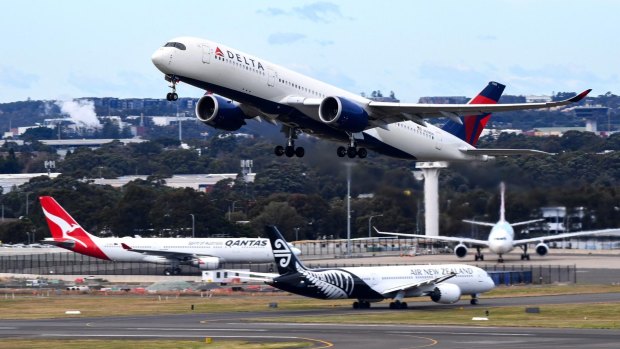This was published 2 years ago
Australia international border closures: How to get permission to leave
By Michael Gebicki

Getting permission from Border Force to leave Australia is just the first step in being able to travel overseas under current restrictions. Credit: Getty Images
My tennis mate Dean just got permission to leave Australia. Submitted the online application for a travel exemption on a Thursday, opened his email the next morning and bingo – permission granted.
After seeing media reports of people being denied a travel exemption to visit sick parents or grandparents unable to visit family in Europe, Dean was in a state of shock. He's a careful fellow – a former lawyer with a large bank – and a stickler for the rules. He once called out his doubles partner's foot fault on the tennis court. Even so, he was shocked and delighted at the speed of his exemption. The way he went about it has lessons for anyone wanting to do the same.
Dean wanted to travel to the UK to visit one son and his family and then travel to Switzerland to visit another son and family, none of whom he'd seen for two years. In support of his application for a travel exemption he had a confirmed flight itinerary showing he intended to be away for longer than three months, and that's important. Also a letter from his doctor plus proof of his double-vaccine status, although that's not a requirement.

Border Force currently lists eight reasons you can apply for permission to leave the country.Credit: James Brickwood
He's retired so the stipulation proving leave from employment didn't apply and there were letters from both sons confirming this was an emotional reunion to see his grandchildren.
The Border Force website lists the following reasons for permission to leave:
- Response to the COVID-19 outbreak, including the provision of aid
- Travelling for business
- Receiving urgent medical treatment that is not available in Australia
- Urgent and unavoidable personal business
- Compassionate and compelling grounds
- Travel is in Australia's national interest
- Travelling overseas for a compelling reason for at least three months
- Ordinarily resident in a country other than Australia
The number of Australians receiving approval to leave the country gradually increased last year, with Border Force citing its new, easier-to-process online portal for applications as the reason. At the start of the pandemic, only one quarter of applications were being approved. The latest figures available (June 2021) show about 40,000 Australians a month leaving the country, but a large proportion of these were heading to New Zealand under the then-open travel bubble arrangement. The number of Australians heading elsewhere about one quarter of this.
However, getting a travel exemption from the Department of Home Affairs isn't the end of the story.
Entry Requirements
Australia still has one of the lowest rates of COVID-19 of any country, and that makes it easier for us to enter most other countries. For example Australia is included on the UK's green list. That means we can enter without the need to quarantine, regardless of vaccination status. The requirements for entry can change quickly and anyone planning a trip needs to monitor the updates posted on their destination's official government websites.
Route planning
In the case of Europe, the route you take to get there might affect what happens at your destination. For example anyone arriving in Italy from Australia may be required to undergo isolation for 10 days, with a negative COVID-19 test required at the end of that period. However you could travel to France – anyone can enter France if they travel direct from Australia – and then to Italy without the need to isolate.
At the time Dean booked his flight to the UK, both Qatar and the UAE were on the UK's red list. That meant flying via either of those countries, even if it was only a transit stop of a few hours without leaving the airport, would have barred him from entry to the UK. That made a flight via Singapore, which sits on the UK's green list, as the default choice. Another option would be a flight via Hong Kong. Both Cathay Pacific and Singapore Airlines are currently operating from Melbourne and Sydney but the Singapore Airlines flights are more frequent and that's what swayed Dean.
Both Qatar and the UAE are now on the UK's less restrictive amber list, and for fully vaccinated travellers, travelling to the UK by Qatar Airways or Emirates would now be an option.
Changes to quarantine requirements can happen at short notice. If you want to stay up-to-date with requirements at your destination, Skyscanner's COVID-19 travel info page is a valuable resource. Skyscanner's COVID-19 travel info page.
COVID-19 test requirements
It's become common to show proof of a negative COVID-19 test to be admitted to any country. The usual time frame for testing is three days pre-flight and there are now several clinics in Australia providing this service for travellers. Douglass Hanly Moir Pathology (DHM) is one and since there's a DHM facility close to Dean that was an obvious choice. Booking via their website was painless.
Key in your flight time and destination and the website responds with a window in which to complete the test. Once you've made your DHM booking the system sends a receipt with a PIN. When the test result is available you'll be notified via a text message to your phone. The PIN is required to open the document with the result.
Several countries including the UK require proof of a pre-booked COVID-19 test to be taken after arrival and there are several providers. Simply Google '(destination) PCR test for incoming travellers'.
Travel insurance
This caused Dean some angst. Policies are expensive for anyone in their 70s. The Department of Foreign Affairs and Trade has applied a 'Do not travel' warning to every country except New Zealand. In the past travelling to a country against government advice might have invalidated travel insurance cover. After a phone call to Allianz, his regular travel insurer, and the reassurance that he would be covered for medical expenses, delays, loss of luggage , car hire excess and all the usual bells and whistles, he went ahead with the policy. The major exception was no cover if he fell sick with COVID-19 while in a country with a DFAT 'Do not travel' warning.
The eagle has landed
I called Dean couple of days after he arrived. It was painless all the way through to London. More checks than usual but he was complimented on the state of his paperwork. The flight to Singapore was only about 10 per cent full he reckons, maybe half full on the Singapore-London sector. He was planning a brisk walk through Holland Park with lunch at Notting Hill. Right now, it sounds as exotic as a trip to the moon.
Sign up for the Traveller newsletter
The latest travel news, tips and inspiration delivered to your inbox. Sign up now.